New progress in scientific research, coming!
Summer is full, and the sun is just right.
It’s graduation season.
It is also the harvest season.
UCASer keeps innovating and making progress.
New discovery of two new "four quark states" hadrons
New progress of eggshell of Hami pterosaur
Reveal the carbon cycle mechanism of vitamin community in biological crust
… …
With Guo Xiaowei
Look at the latest issue of scientific research express
01 led the discovery of two new "four quark states" hadrons.
Progress has been made in the study of eggshell composition of Hami pterosaur
Joint research and publication of high quality reference genome of Arabidopsis thaliana
Progress has been made in the study of epigenetic mechanism of perfluorooctanoic acid exposure interfering with reproductive endocrine.
USP7 degradation agent was proposed as a potential therapeutic strategy for p53 mutant cancer.
Revealing the carbon cycle mechanism of microbial community in biological crust
Revealing the evolution mechanism of microstructure of sulfur dioxide aerosol by Dalian light source
08 reveals the ligand recognition and G protein selection regulation mechanism of some serotonin family receptors.
Cloning of important genes regulating soybean grain size and quality

Click on the corresponding title below to read the original report.
Click on the journal name to learn more.
Leading the Discovery of Two New Quaker Hadrons Recently, the LHCb International Cooperation Group of the Large Hadron Collider at CERN announced the discovery of three new exotic particles: a new five quark hadron and two new four quark hadrons which are mutually adjoint states. Among them, two "four quark states" hadrons were discovered by the particle physics team of National Science and Technology University, one with two charges and the other neutral. Their internal structure is very strange: they contain four different types of quark components, and their mass is about 3.1 times that of protons.
This is the first time that a double-charge "four-quark state" hadron has been discovered experimentally, and it is also a hadron partner that has found two completely new quark components at the same time. At the same time, the discovery of these two "four quark states" hadrons provides brand-new experimental evidence for confirming the existence of new material forms beyond the conventional baryons and mesons in nature, which will help deepen human understanding of the most basic structure of matter in the universe. Undergraduate and graduate students of the National Science and Technology University played a key role in it.

Mars, a doctoral supervisor of the National Science and Technology University and a doctoral student of Wang Xiaolin, a researcher at the Institute of vertebrate paleontology and Paleoanthropology of the Chinese Academy of Sciences, cooperated with Luo Wugan, an associate professor at the School of Humanities of the National Science and Technology University, to analyze and study the egg fossils of Hami pterosaur in Tianshan Mountain. The results revealed that the main component of the protein-colored eggshell of the pterosaur was fluorapatite.
This study is of great significance to the research and protection of pterosaurs and pterosaur egg fossils. Related research results were published in Heritage Science. Mars is the first author, and Wang Xiaolin and Luo Wugan are the corresponding authors.
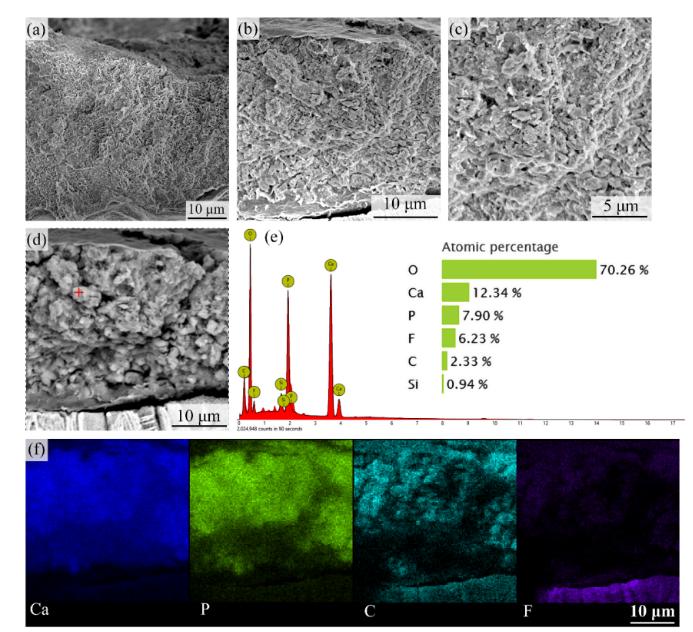
Collaborately researching and publishing high-quality reference genome of Arabidopsis thaliana, Wang Ying, an associate professor at the School of Life Sciences of the National Science and Technology University of China, cooperated with Jiao Yuling, a doctoral supervisor at the National Science and Technology University of China and a researcher at the Institute of Genetics and Developmental Biology of the Chinese Academy of Sciences, and obtained a nearly complete reference genome Col-PEK of Arabidopsis thaliana Col-0 ecotype by combining long-reading ONT, high-fidelity long-reading PacBio HiFi and short-reading Illumina NovaSeq sequencing data. Col-PEK assembly filled most gaps in all regions including five centromeres.
The related research was published online in Molecular Plant with the title of "A Near-Complete Assembly of an Arabic Genome". Hou Xueren, a doctoral student at National Science and Technology University, is the first author, and Wang Ying and Jiao Yuling are co-authors.
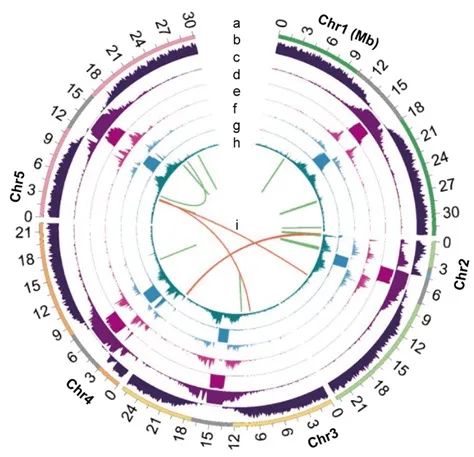
Progress has been made in the study on the epigenetic mechanism of perfluorooctanoic acid exposure interfering with reproductive endocrine. Huang Qingyu, a graduate tutor of National Science and Technology University and a researcher at the Institute of Urban Environment of Chinese Academy of Sciences, revealed the mechanism of histone modification in PFOA interfering with male reproductive endocrine by analyzing the effects of low-dose PFOA exposure on the expression of key genes in testosterone synthesis, the level of hormone synthesis and the status of histone modification (methylation/acetylation) in rats.
The research results were published in environmental science & technology with the title of "low levels of perfluoro petrochemical acid exposure activations steroid hormone biosynthesis through reproducing histone methylation in rats". Han Xueying, a master student of National Science and Technology University, and Md Nur Alam, a doctoral student, are co-first authors, and Huang Qingyu is a correspondent author.
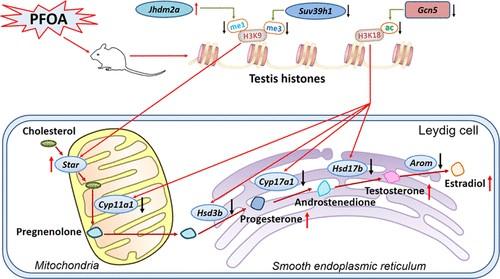
USP7 degrading agent was proposed as a potential therapeutic strategy for p53 mutant cancer. Zhou Bing, Li Jia and Zhou Yubo, doctoral supervisors of National Science and Technology University of China and researchers of Shanghai Institute of Pharmacology, Chinese Academy of Sciences, designed and synthesized the first small molecular probe U7D-1 with high efficiency and selective degradation of USP7, and studied its antitumor activity and mechanism in p53 wild-type cells and p53 mutant cells.
The related research work was published online in angew.chem.int.ed. with the title of "discovery of a potential and selective degrader for USP 7". Pei Yuan and Fu Jingfeng, Ph.D. students of National Science and Technology University, and Shi Yunkai, postdoctoral fellow of Hangzhou Institute of Advanced Studies of National Science and Technology University, are co-first authors. Zhou Bing, Li Jia and Zhou Yubo are co-authors.
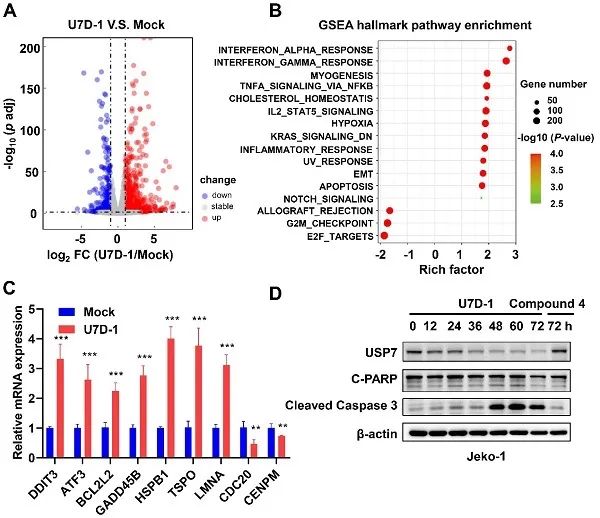
Ho Xuan Huong, a doctoral supervisor of National Science University of China and a researcher of Institute of Hydrobiology, Chinese Academy of Sciences, conducted five batches of sampling surveys for four consecutive years on biological crusts (algae crusts, cyanobacteria lichen crusts, green algae lichen crusts and moss crusts) in different succession stages of typical field plots. By using various metagenome technologies and big data model analysis methods, combined with the determination of enzyme activities at physiological level and the correlation analysis of environmental factors, the microbial carbon cycle pattern and its interaction and regulation mechanism of biological crusts were revealed.
The related research results were published online in Soil Biology and Biochemistry with the title of "carbon cycle in the microbial ecosystems of biological soil crusts". Wang Qiong, a doctoral student at National Science and Technology University, is the first author, and Ho Xuan Huong is the correspondent author.
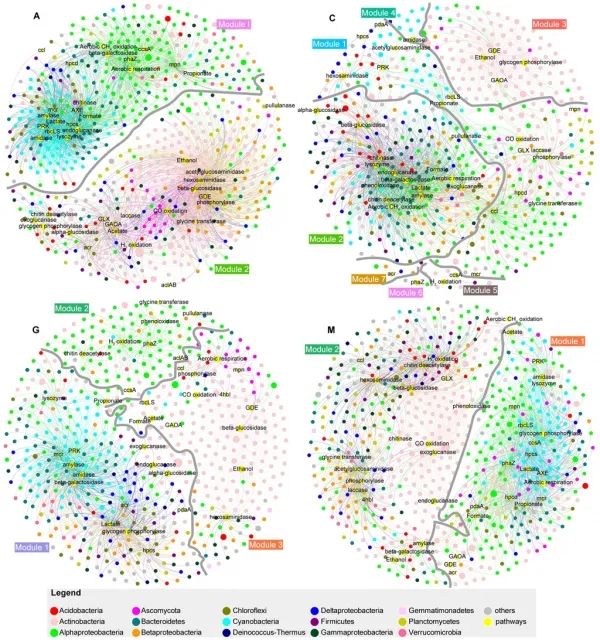
Using Dalian light source to reveal the microstructure evolution mechanism of sulfur dioxide aerosol, Jiang Ling, a graduate tutor of National Science and Technology University of China, a researcher of molecular reaction dynamics State Key Laboratory of Dalian Institute of Chemistry, Chinese Academy of Sciences, and Zhang Zhaojun, an associate researcher, discovered the structural evolution mechanism of sulfur dioxide hydrated clusters by using a self-developed infrared spectrum experimental device based on Dalian coherent light source, which provided a new idea for understanding the nucleation mechanism of sulfur dioxide aerosol. This achievement helps to clarify how pollutant molecules grow into clusters step by step, so as to help people better understand the formation mechanism of smog.
The related results were published in the Journal of Physical Chemistry Letters with the title of "Infrred Spectroscopy of Stepwise Hydration Motives of Sulfur Dioxide". Chong Wang and Fu Liangfei, Ph.D. students of National Science and Technology University, are co-first authors.
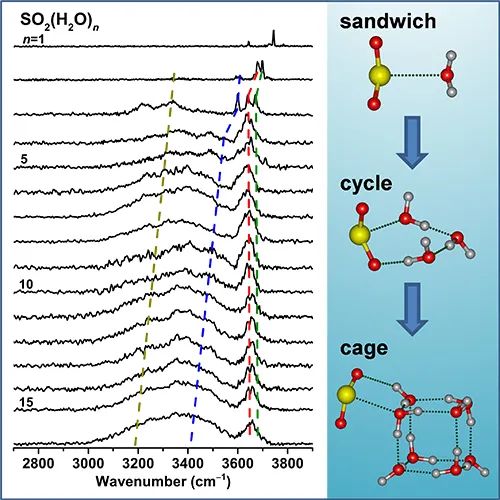
Revealing the ligand recognition and G protein selection and regulation mechanism of some serotonin family receptors, led by Xu Huaqiang, a doctoral tutor at National Science University and a researcher at Shanghai Institute of Pharmacology, Chinese Academy of Sciences, together with Zhang Yan, a professor at Zhejiang University, and David E. Gloriam, a professor at Copenhagen University, Denmark, etc. The research results "gpcrs steergi and GS selectivity via tm5-tm6 switches as revealed by structures of serotonin receivers" were published online on Molecular Cell. Huang Sijie and Xu Peiyu, Ph.D. students of National Science and Technology University, Shen Dandan, research assistant of School of Basic Medicine of Zhejiang University, and Icaro A. Simon, University of Copenhagen, Denmark are the co-first authors of this paper.
This study has made another progress in the field of structure and function of serotonin receptor, and successfully analyzed the three-dimensional structure of 5- HT, 5-HT, 5-HT receptor and activated G protein (Gs protein) and 5-HT receptor and inhibited G protein (Gi protein). The structural basis of small molecular ligands 5-HT and 5-CT recognizing 5- HT receptor subtypes was revealed, and the molecular mechanism of 5- HT receptor selectively coupling Gs protein and Gi protein was clarified. Huang Sijie and Xu Peiyu, Ph.D. students of National Science and Technology University, Shen Dandan, research assistant of School of Basic Medicine of Zhejiang University, and Icaro A. Simon, University of Copenhagen, Denmark are the co-first authors of this paper.
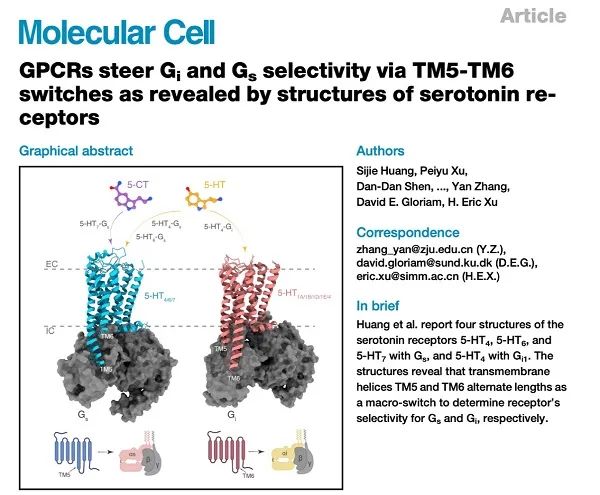
Tian Zhixi, a doctoral supervisor of National Science and Technology University of China and a researcher of Institute of Genetics and Developmental Biology, Chinese Academy of Sciences, cloned an important gene regulating soybean grain size and quality. Through genome-wide association study analysis of more than 1,800 soybean germplasm resources, a stable signal interval related to grain thickness was identified on chromosome 5, which overlapped with many reported candidate QTL intervals for yield, oil content and protein content. The team further combined with the analysis of multi-omics data to determine a gene GmST05 (Seed Thickness 05) which controls the thickness and size of soybean seeds.
The research results were published online in Plant Biotechnology Journal with the title "Natural Allelic Variation of GMST 05 Controlling Seed Size and Quality in Soybean". Duan Zongbiao, a doctoral student at National Science and Technology University, and Sharla Cheung, an assistant researcher, are co-first authors, and Tian Zhixi is a correspondent.
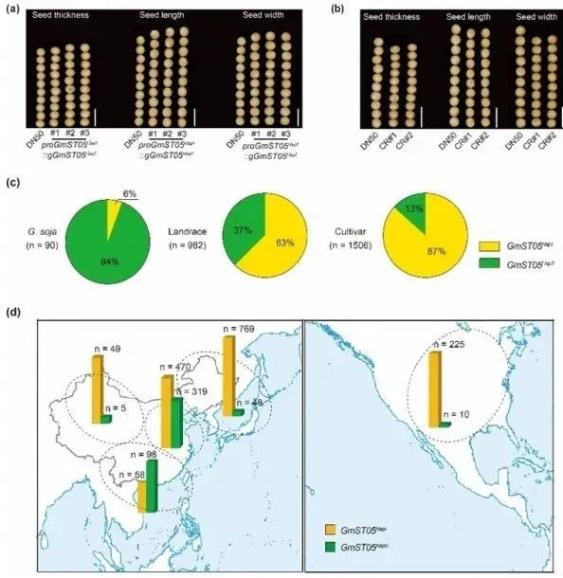
This issue of scientific research express is here.
Original title: "New progress in scientific research, coming! 》
Read the original text